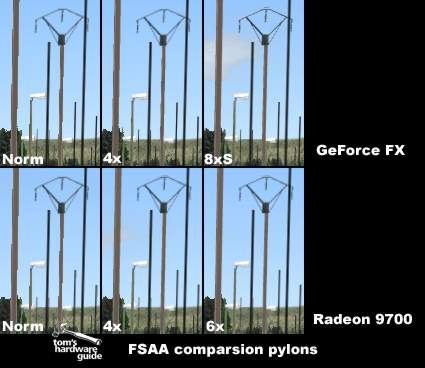THG Graphics Card Buyer's Guide
FSAA And AF
The abbreviations FSAA and AF stand for two methods of improving the image quality in 3D games. FSAA is short for Full Scene Anti Aliasing, which is a technique for smoothing the edges of 3D objects within a scene. AF is shorthand for Anisotropic Filtering, which is a filtering method applied to textures on 3D objects to make them look crisper and less washed-out, greatly enhancing image quality. Both FSAA and AF are very demanding on graphics processors, especially when used in combination.
These features can usually be enabled or disabled through the graphics driver's control panel. Some games also let you enable them directly through the in-game options menu, without the need for special software. However, some games have trouble with FSAA, due to peculiarities of the graphics engine they use. In these cases, leaving FSAA disabled is usually the better choice, as image corruption can occur otherwise.
The advantages of FSAA become especially obvious on slightly slanted vertical object borders.
Anisotropic filtering results in much crisper textures.
Although the underlying principles are the same everywhere, the technical implementation of these techniques differs from company to company and even from one card generation to the next. On older graphics cards or newer low-end models, FSAA can only be used to a limited extent; this is usually either because the card's performance is too low to deal with the extra calculations, or because it uses a slow or outdated FSAA method. There are also a number of different AF methods that differ both in calculation complexity and resulting image quality.
Both FSAA and AF require a lot of computing power and memory bandwidth. For this reason, ATI and NVIDIA use heavily "optimized" versions of these methods to achieve better results (higher performance) while still offering greatly improved image quality compared to the standard rendering output. The heaviest optimization is done on the anisotropic filtering implementations. As a result, there are some cases in which a reduction in image quality compared to the "correct" or "real" method becomes visible. Unfortunately, both of the big players like to use this method of tweaking too much in order to try to win benchmark comparisons. Therefore, image quality and performance can differ immensely between driver versions even on the same card!
You can read up on the texture filtering "optimizations" currently in use in the following article: ATI's Optimized Texture Filtering Called Into Question .
Get Tom's Hardware's best news and in-depth reviews, straight to your inbox.

